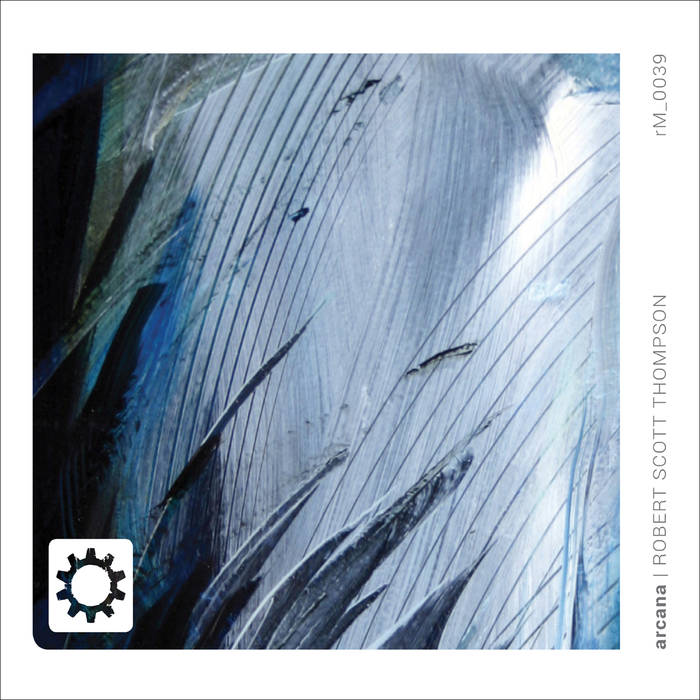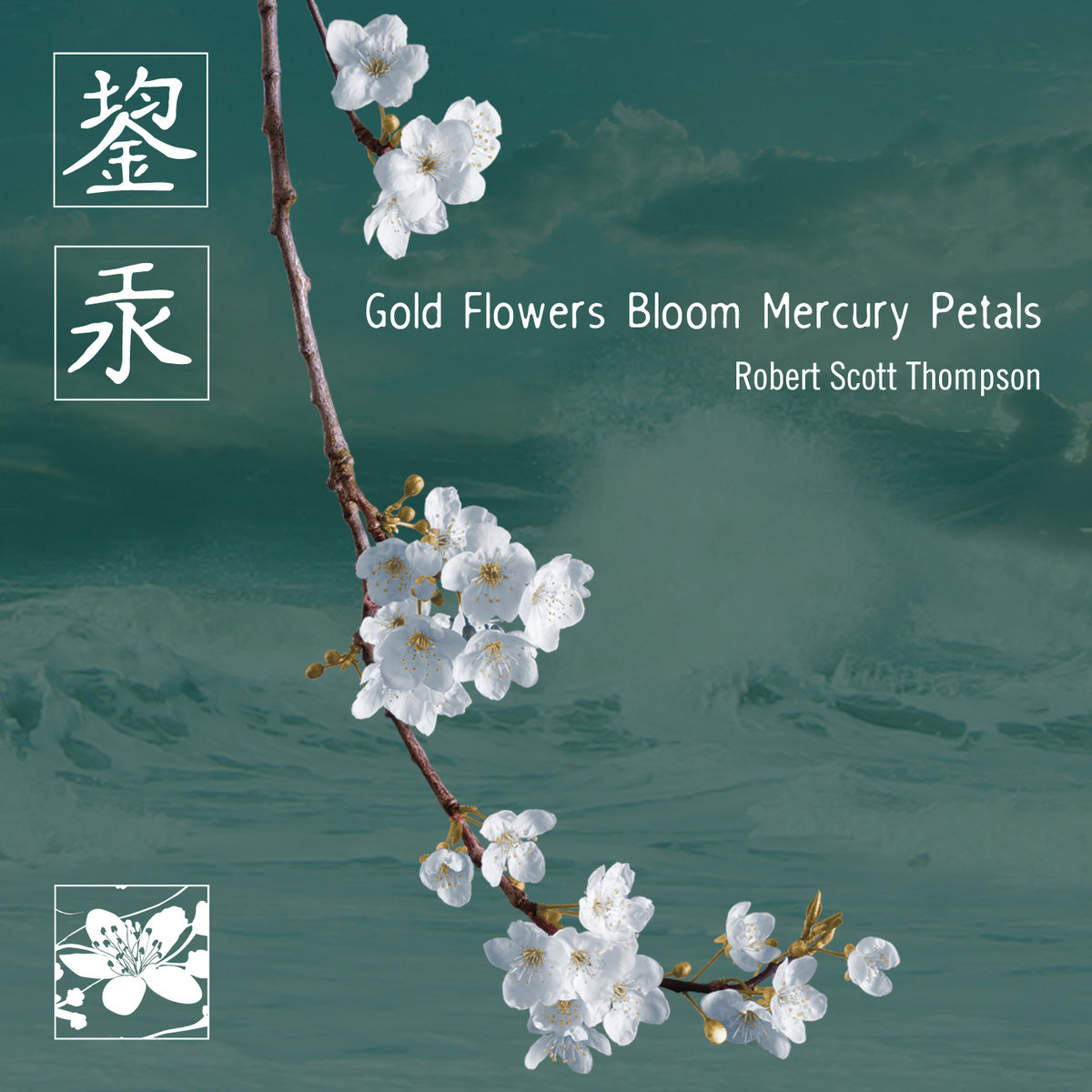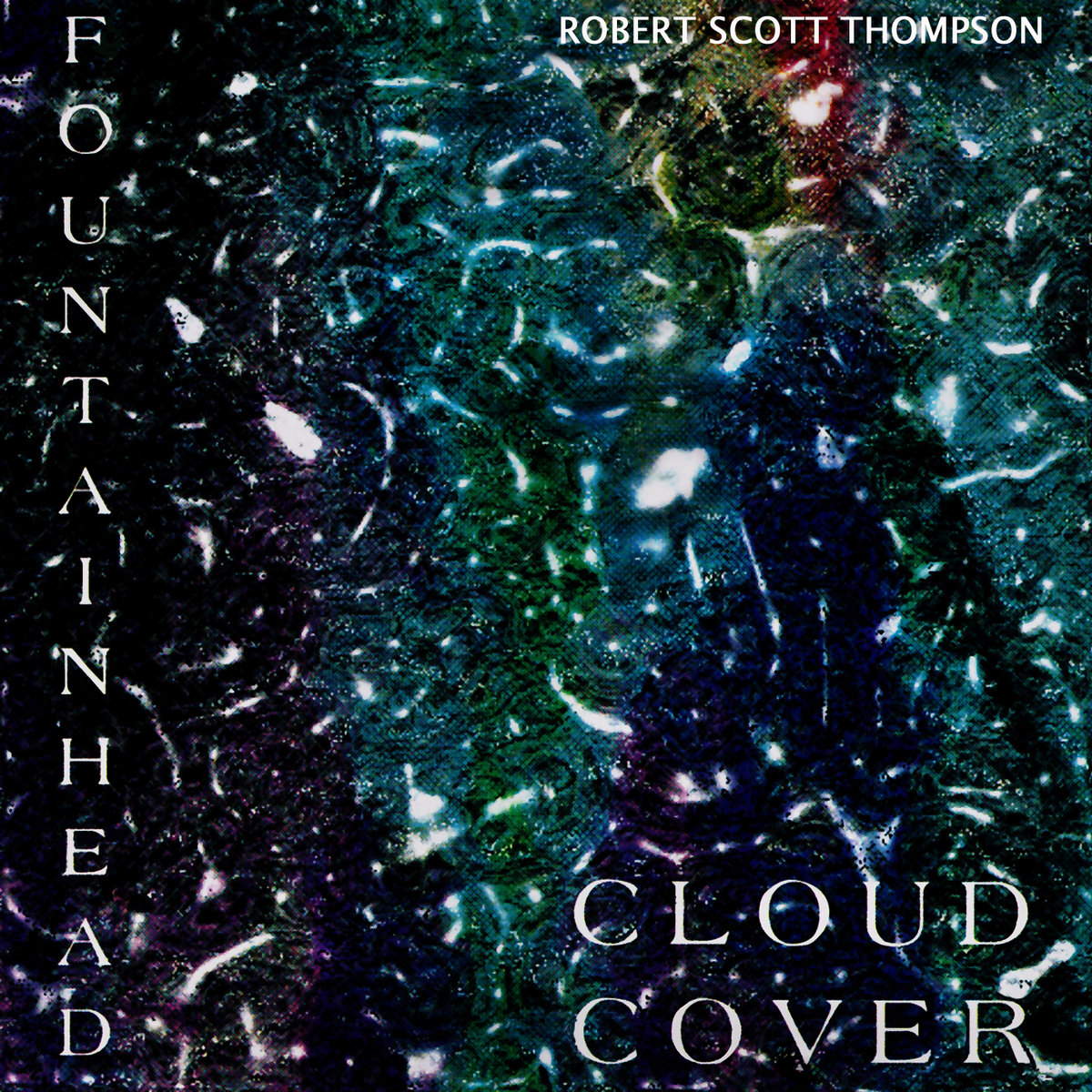Listen to
Upon the Edge of Night

Upon the Edge of Night (2012) — Robert Scott Thompson — Ambient Music
...wintry soundscapes of free-floating drift...
Upon the Edge of Night, the latest collection from prolific electroacoustic composer Robert Scott Thompson, came about in interesting manner. Rather than developing as a formally conceived stand-alone work, its eight compositions were culled from studio sessions for the albums Shadow Sense, The Active Side of Infinity, and Dragging the Sea With Dreams, all of which are slated for release in 2013 on various labels. Upon the Edge of Night is no less satisfying for being so, however, as it holds together as a cohesive work due to the individual pieces’ allegiance to a common style—ambient moodscaping. The listener certainly gets his/her money’s worth, too, as the release presents ninety-six minutes of material, in physical form essentially equivalent to two CDs of fifty-minute duration. Acoustic and electric pianos, synthesizers, percussion, and electronics are the primary resources Thompson mines in crafting his wintry soundscapes of free-floating drift.
The opening piece sets the tone for the recording as a whole. Though the soft tinkle of a piano appears throughout, “Strange Lines and Distances” is dominated by gauzy atmospheres and the celestial murmur of angelic voices, with the latter imbuing the piece with a rather New Age-like quality. “Glass is the Enemy of the Secret” does, in fact, exude a glassy character in the sharp-edged sonorities that accompany the setting’s otherwise soft glimmer. There are brooding set-pieces (“Far Side of the Sky,” “Pale Fire”) and immersive, slow-motion meditations (“A Winter’s Music”). At one end are pieces of extended duration (“Strange Lines and Distances” and “A Winter’s Music” both exceed the sixteen-minute mark) that contrast with pieces of intense compression (“Shadow Sense,” the minute-long vignette “Listening Before Radar”).
If there’s one piece that stands apart from the rest, it’s “Buckna to Slemish”—though not unappealingly. The four-minute setting is the prettiest one of the bunch and the most melodic, too, and consequently the sweetly sentimental lullaby immediately jumps out at the listener the moment its radiant content appears. With its simulated flute and harp sounds leading the way, “Variation Reveals” is almost as memorable, even if its mood is significantly more melancholy by comparison. It might be tempting to be dismissive of Thompson’s work, given the amount of material he releases, but doing so would under-appreciate its consistently high quality. If anything, the listener should come away from Upon the Edge of Night impressed that he’s able to produce recordings of superb quality with such regularity.
— Textura
Intelligent and measured...
I picture two lovers trading glances in a glass hall full of mirrors, the shades of their clothes and garments penetrated by black ice light from a parallel universe to Steve Roach’s REM sleep. The sleep tosses and turns while they dance, the experimented-upon participant giving nimble steps to the lover’s as they move in ebb and flow, to and fro drone. These sounds are not frought with suspense: they interact like a diastolic heart rate measurer and calm you down instantaneously. Texture is a strong feature, continually being rewoven with a natural capacity. Intelligent and measured are two keywords for Robert Scott Thompson’s music from Aucourant, something that takes your breath away and then gives you back those breaths to rest easy and age kindly.
Highlight track: “A Winter’s Music” – replay value.
— Muttley
Robert Scott Thompson always delivers significant signature, versatility and refinement...
Robert Scott Thompson describes himself as a musical alchemist and this is definitely the best description suiting to his soundsculptings. RST crossed my radar for the first time during the second half of the 90’s with his two stunning works, “The Silent Shore” (1996) and “Frontier” (1998), released on Canadian Mirage label. At that time he had released about 6 other albums, yet still remained quite unrecognized.
Now, 15 years later, Robert Scott Thompson owns huge discography counting over 50 solo albums and collaborations, with nearly all of them released through his own Aucourant Records (Hypnos and Lens Records are few exceptions), ranging from more ambient infused titles through electroacoustic, acousmatic, avantgarde and contemporary electronica to more minimal meditative.
“Upon The Edge Of Night” album, released on Aucourant Records during December of 2012 as a CDr edition packaged in elegant digipak, has immediately caught my attention with its title and cover images. 16 and half minutes long opener “Strange Lines And Distances” ranges in the same category with Robert’s above mentioned ambient jewels such as “The Silent Shore” and “Frontier”. Tranquilly floating dronescaping ambience is masterfully emphasized by gorgeously infinite celestial choir-like gracefulness and few distant piano embellishments. Some cool strange sounds emerge here and there. Warmly inviting and hauntingly expansive beginning, pure beauty, more please!!!
Nicely titled “Glass Is The Enemy Of The Secret” shifts straightly into more textured terrains, although backing panoramas remain soothingly sweeping and the main motifs are gently harmonious and poetic with some additional, fragile swirling synthesized glass-like fragments precisely displaying the track title. All quite sparse and evocative. “The Misty Place” keeps minimal feel of its predecessor. Contemplative atmofields are precisely bridged with translucent tinkles and few ear-catching disruptions pop-up throughout. The piece slowly evolves then again fades into calmer passages, but always having its balmy and nostalgic mood. Essentially sedative journey!!! And it overlaps also to the next composition entitled “In The Flow That Follows”. It blends relaxing organic sounds and soft urban rumbles with deeply evocative, cinematic blankets, wistful piano and sluggish strings. Subtly pleasant sceneries arise, quietly relaxing and gently immersing, and for long time buried memories start to awake. Utterly captivating masterpiece!!!
“Listening Before Radar” is a short, transitional piece sounding slightly more discordant when comparing to previous cuts. “Far Side Of The Sky” returns again into enveloping panoramas, this time with its eloquently sorrowful touch. “A Winter’s Music” is another longer piece, clocking to 16 and half minute mark. Quietly expansive dronescape is attractively colored with highly expressive and captivating strings with some softly swirling trinkets attached. A truly magnificent, deeply meditative composition masterly displaying serene atmosphere of gorgeously glimmering winter wonderland!!! The closing title track, “Upon The Edge Of Night”, reveals all the magic of nightfall heaven with coalescing splendidly ethereal washes with bass hums, singing cicadas and ephemeral organics and chimes. Brilliantly beautiful finale bringing to mind (along with “In The Flow That Follows”) “The River Of Appearance”, one of the great classics.
“Upon The Edge Of Night” is undeniably a very strong album, it quickly became one of my fave atmospheric ambient works by this highly crafted composer, who is currently a Professor of Music Composition/Music Recording Technology at Georgia State University School of Music in Atlanta. I think this recording is still mostly unrecognized, it’s a big shame, because Robert Scott Thompson always delivers significant signature, versatility and refinement in his music. This virtuosity certainly deserves to be explored!!!
— Richard Gürtler
...an interplay of elemental forces takes place...
Upon The Edge Of Night, by Californian Ambient veteran and synthesist Robert Scott Thompson, is many things at once, an important thing to note if one considers its inclusion in my annual Winter Ambient Review Cycle. Its title does not feature particularly icy vocabulary, but since I am writing about music – by means of analyzing track titles as well, I have to admit – this does not prevent me from linking it to the coldest of all seasons. Released in December 2012 on the artist’s own Aucourant Records and available to purchase and fully streamable at Bandcamp, Upon The Edge Of Night is nevertheless on the edge of consideration and almost failed to be included in said cycle, but this assertion does not reflect on the quality by any means. It rather has to do with the humble reviewer’s strictness. But first things first: the album features eight compositions of the New Age-inspired kind (aka the Berlin School), and yes, all of them aurally illustrate a certain aloofness and peaceful unfolding of events, an important assessment, given that these eight pieces derive from three different – back then forthcoming – albums. Kosmische synth pads conflate with wind chimes, processed as well as transparent guitar twangs and, last but not least, a classic piano. No goblet drums, Native percussion devices or similar artifacts are included, and the lack thereof might convince readers to deny this work the New Age label. Fair enough. For the time being, I still call it that, but am also keen on its Drone-underpinned side and heliospheric spirit. And yet it comes down to this question: what endemic element, texture, source or lack thereof did almost prevent the album from being included in the Winter Ambient Review Cycle 2013? It is warmth. Rivers of warmth. Upon The Edge Of Night is a silky affair, but in its nucleus, an interplay of elemental forces takes place. In the following paragraphs, I carve out the outcome from my viewpoint and the reasons to consider this work regardless.
Strange Lines And Distances is the gateway to Robert Scott Thompson’s album. Ethereal synth cherubims sing in front of a dark yet benign rivulet of droning bass runlets. Silkened electric piano globs scintillate between the interstices and cusps. Muffled cyber-oid laser sounds shoot through the thickly wadded aura of contentment. The billow-like nature allows for the afterglow of the synths and makes the track appear cold, hollow… and winterly. Within each interim fade-out phase, density and warmth decrease, and these are devices that go hand in hand on this track. Later on, only the synth choir inherits the wave-like nature, as warmth gains the upper hand via a prolonged drone stream of golden colors. In the end, however, the glassy shades and spheroidal translucency spawns bluer timbres. As the song slowly fades away, tiny protrusions of the warmer schemes try to tower above the scenery one last time, functioning as a marker of bliss despite the increasing coldness. The follow-up Glass Is The Enemy Of The Secret is a track with a great plasticity: Space-Age strings unite with concave spheres and vitreous synths. Sound, sustain, silence and their entanglement are the principal modules of this construction. Despite the faintly portentous dark matter injections, peacefulness reigns. Dun-colored but illumined by whitewashed wind chimes and fluttering sparks, Glass Is The Enemy Of The Secret is almost cheeky in the portrayal of its mysteries and surprisingly interspersed with amicable overtones.
The third track, called The Misty Place, is definitely a cavity or antrum of some sorts: vaulted and reverberated turquoise-colored cosmic marimba pads become enmeshed with comparably piercing high-rise coruscations and temple bells. Here, the mood is truly enigmatic, but lofty and aeriform enough to prevent the architecture from being mistaken for a listener-swallowing New Age grotto. Long sustain phases and an infinitesimal level of haze let the listener feel the cove’s altimeter via repercussion. Up next is In the Flow That Follows, a piano arrangement with staggering keys at its core, but ameliorated by warmhearted synth cascades and galactic glitters. The track showcases the duality between fragility and voluminosity, or better still, the possibility of their harmonious coexistence. Vernal warmth and hibernal coldness coalesce in piece. And what a surprise, there is even a sort of intermission included on the album: Listening Before Radar is an ultra-short vignette that is even shy of the 90-seconds mark. Consequently, Robert Scott Thompson wastes no time and defines the precious capsule immediately. The artist envisions a place of shelter with the attributes of liquid field recordings, arcane cymbals and acidic juxtapositions of the mesmeric kind. It is comparably bustling, but retains the grace of Ambient music.
Far Side Of The Sky probably addresses the prescriptive conditions of the Berlin School best, as this is the one piece that does not hide its antediluvian complexion. Probably purposely dated and weary synth formations gyrate around another staggering and seemingly aleatoric piano melody. The female cherubim is back, her synthetic voice conflating with the – actually very embraceable – square lead protuberances. These fit well with the admonitory undertone that is spawned throughout the runtime. Maybe a forewarning of the night that is yet to come? In any way, A Winter’s Music, the album’s seventh track, definitely justifies the inclusion in my Winter Ambient Review Cycle. A long-form piece of 16+ minutes, A Winter’s Music emanates a vertiginous amount of iciness, gales and elasticized icicles that are transformed into music. Cracking ice and Glitch-evoking pops and crackles are additional adjuvants to the perception of coldness, with the slapped guitar being the only source of bonfire-like proportions, shimmering through the night, spending warmth and comfort. The second half sports dark bass drones and starkly translucent synths. The heavy reverb increases the perception of wideness, with the title track and finale Upon The Edge Of Night being equally glacial due to its superimposed synth sinews of the euphonious kind; even euphoria is interwoven. The different textures create a curious effect: is this a warm arrangement or a cold one? Bumpy bass eruptions nurture the warmth, crickets and cyber birds squawk through the night of a late 80’s virtual reality scenery.
Robert Scott Thompson’s Upon The Edge Of Night may sit in-between many a timbre and genre-driven expectancy, but the result, while comprising of works for different albums and thus phases, still feels cohesive enough to justify its status as an album. The definite place of the prolific composer’s album is harder to pinpoint. Granted, it is part of my annual Winter Ambient Review Cycle, so it must be at least somewhat glacial, and this is exactly the case indeed. However, this is neither a work of exclusively New Age-focused patterns à la ancient cavities as found in The Misty Place or oft-considered odes to snow-covered landscapes such as A Winter’s Music, nor an exclusively nocturnal voyage as the album and title track evoke, and the reason for this is emitted by the thermal heat source that is transformed into music. Whatever this means to the respective listener, whether it is polyphonic enchantment, wondrously blurred surfaces or soothing susurrations, Upon The Edge Of Night does opaquely greet the listening subject even in the most forsaken of its aural places. There is New Age music – excellent New Age music, I might add – which features incredibly saturated and incandescent textures, magnanimous amounts of layers and helical ornaments en masse. Thankfully, and almost oddly so, Robert Scott Thompson does not succumb to these production techniques, even though he is close to the source and only one small step away. In lieu of bolstering, boosting or revving up the layer entanglement, he lets darkness in. Ain’t I a genius: Thompson lets darkness in on an album called Upon The Edge Of Night. But there is more to it than that. The backdrop of nonentity which is only illuminated by the long sustain and reverb phases, actually serves as a cold counterpart to the warm mellowness which graces the opener and traverses through all subsequent compositions. The luminary hence makes use of warmth as an antagonistic force, and at least in wintery Ambient works, warmth can be considered de trop. But it makes things all the more interesting. Shuttling between New Age, vestiges of Drone, and the cosmos of Space Ambient, Upon The Edge Of Night worships darkness, coldness and quieter unfolding, but never dismisses the energy of benignancy.
— Ambient Exotica
A fantastic release and well worth looking into.
Let me say from the outset that Upon the Edge of Night, the latest release from prolific electro-acoustic composer Robert Scott Thompson, is one of those albums that brings to mind the old quote, “Writing about music is like dancing about architecture.” It’s not a release that will benefit from a written review; it needs to be given a deep, focused listen. While I don’t do “Best Of” lists, I would have to say that this easily stands out for me among the releases I’ve listened to this year. Across 13 tracks, Thompson touches on classic ambient drifts, neo-classical structures, and light sequencer music, all with equal grace and mastery. This is my first exposure to Thompson’s music, and I’m amazed at what I’ve been missing. Upon the Edge of Night is actually a collection of pieces “culled from a large number of studio sessions” for three upcoming releases–which makes 2013 a very promising year for listeners. It also accounts in part for the diversity at work here. Thompson opens the disc with the very soft ambient tones of “Strange Lines and Distances.” The piece has a lush, warm sound, punctuated with quietly repeating piano notes. Then, having spent 16 minutes convincing you you’re in a very good ambient disc, he greets you with “Glass is the Enemy of the Secret,” an almost playful little tune on the edge of electronic chamber music. It reminds me in spots of a slightly tamer Roedelius. And the changes continue from there, all the transitions smoothly made. He again takes the listener deep into a dream-like realm with the gorgeous flow of “The Misty Place.” Organic touches and a distinct progression of sound mark the journey here. There’s also a rich sense of emotion, admittedly on the melancholy side, that connects and draws you in. The slow piano of “Far Side of the Sky” is paired off with long string pads, Thompson letting the space between notes and the fading resonance have their say in the story. The twilight-hued “In Situ” is a borderline drone piece, sizable pads moving in a slowly advancing line. Another track that just takes hold of your mind and holds it still while Thompson works on it. “Variation Reveals” is like a pastorale on piano, flute, and strings, a straightforward, classically oriented piece. “Pale Fire” closes the disc with energetic sequencer constructs and interruptive sound manipulation. Spacey and a little odd…I like it.
Thompson takes advantage of the basically limitless size of digital model and provides a full 90 minutes of music here. That time glides by as he wends his way through styles. Nothing feels out of place or contrived; Thompson simply has this range, and he covers it well. A fantastic release and well worth looking into.
— Hypnagogue
RELATED RELEASES






Reviews